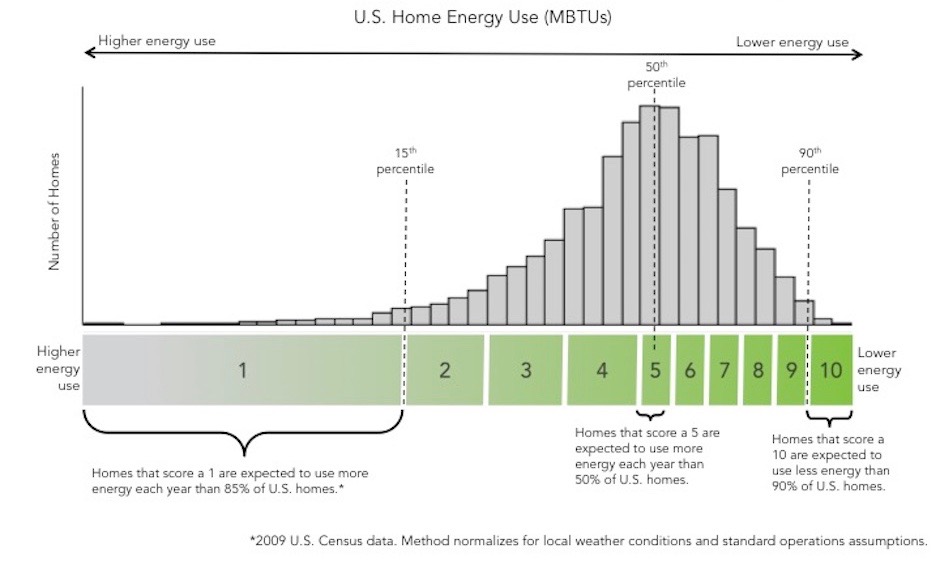These days, there is a significant amount of buzz around numbers relating to energy efficiency when it comes to new and existing homes. Is a high number good or bad? If the original number was high, and now, after improvements, it is lower, what does that mean for the house?
Unfortunately, the answers are not cut-and-dried; they depend significantly on the rating system being used.
Home Energy Rating System (HERS) Index and Home Energy Score (HES) are two of the programs with numbers swirling around them. Which numbers are good? And how do builders, designers and sales teams communicate that to buyers? Let’s take a look.
On a scale of 1 to 10
HES is a 1-to-10 scale developed in 2012 by the Department of Energy (DOE) to help predict homes’ energy performance. This score is similar to a vehicle’s miles per gallon, but for a home’s energy efficiency. When one purchases a car, knowing how much fuel it will use over time and that cost to the owner is much like knowing the cost of energy to operate a home through its score. As with miles per gallon, a higher HES is better than a lower one. A score of 1 means the home uses more energy and is less efficient; a score of 10 means the home uses less energy and is more efficient.
The average home falls right in the middle of the scale, scoring a 5. The HES scale is only used for single-family homes, including duplexes and townhomes, and is popular among existing homes. It is not available for multifamily or mobile homes.
To obtain a HES, an assessor walks through a home, inputting up to approximately 50 data points into software. These data points include assets such as the building envelope, HVAC systems, and wall components. Once the data entry is complete, an overall score and a list of suggested upgrades to get the score closer to a 10 is generated.

It is important to keep in mind that the HES uses estimates instead of actual homeowner energy usage data to create the score. The HES also does not measure energy per square foot. If two homes were the same overall except size, it would show the larger house having lower efficiency.
The HES is a quick, easy and affordable assessment to help home owners understand how the home uses energy and how to improve. It can be a great way to showcase how a home compares to those around it or how its energy efficiency improves with upgrades. More than 21 states have adopted the use of HES, and it can even be seen on an MLS in some areas, perhaps increasingly so in the future.
How low can you go?
The HERS Index is a rating system released in 2006 by the Residential Energy Services Network (RESNET), a nonprofit with a mission to make homes more efficient and reduce utility costs to the home owner. HERS is recognized by the DOE, the Environmental Protection Agency and the Department of Housing and Urban Development.
HERS functions like the game of golf; the lower the score, the better. A rated home is given a score based on its energy performance on a scale from 1 to 150 (although higher and lower numbers are available). This number comes from a comparison of a rated home to a similarly sized and designed model home. The model home is derived based on the International Energy Code of 2004, which would receive a rating of about 100 on the scale. Older houses average somewhere higher on this scale, about 130 and up. HERS ratings can be performed on single-family, multifamily or mobile homes.
The HERS Index takes into consideration air leakage in the whole house and the duct work, the specific energy use of the home through its major appliances, and also insulation in ceilings and walls. All of this data is gathered by a HERS rater, who is trained to look for details in each home and perform specific tests. This thorough examination into how a home uses and loses energy takes a few hours. The findings are input into software that analyzes the results and indicates recommended upgrades for a home.

This allows builders to showcase energy-efficient details of their homes that might not otherwise be seen. Benefits that are often hidden by drywall or are hard to explain now have their moment in the sun. The HERS score is a comparable number, allowing for clear communication of value, while also predicting future performance for the rated home.
Summing up, HES is a quick and more general approach based on estimates; the higher the number, the better. HERS looks at each home more comprehensively, which make take longer; the lower the number, the better. There is a place for both HES and HERS in the housing industry; it all depends on how much time and money a home owner wants to spend on increasing the efficiency of their home.
The original article, written by Megan Alise Carroll, was published in the Spring 2017 Issue of Best in American Living.

